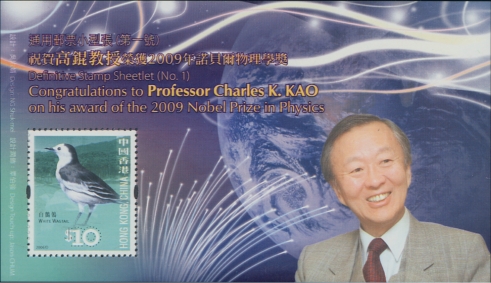Charles Kuen Kao is known as the “father of fiber optic communications” for his discovery in the 1960s of certain physical properties of glass, which laid the groundwork for high-speed data communication in the Information Age. Before Kao's pioneering work, glass fibers were widely believed to be unsuitable as a conductor of information because of excessively high signal loss from light scattering. Kao realized that, by carefully purifying the glass, bundles of thin fibers could be manufactured that would be capable of carrying huge amounts of information over long distances with minimal signal attenuation and that such fibers could replace copper wires for telecommunication. He shared the 2009 Nobel Prize in Physics with Canadian physicist Willard S. Boyle (1924-2011) and American scientist George E. Smith (1930-), coinventors of the charge-coupled device, which is used to convert optical information to an electrical signal. Fiber optics and charge-coupled devices made possible the broadband communications on which contemporary medical informatics and electronic publishing depend, as well as specific imaging devices in ophthalmologic equipment and microscopes.
Kao was born on November 4, 1933, in Shanghai, China. His father was a lawyer who received his JD degree from the University of Michigan (United States) in 1925 and became a professor at Soochow University (Shanghai). As a boy, Kao studied Chinese classics at home with a tutor and learned English and French at an international school in Shanghai.
In 1948, Kao's family moved to Hong Kong, where he completed his secondary education at St Joseph's College in 1952. He then went to England, where he did his undergraduate studies in electrical engineering at Woolwich Polytechnic (now the University of Greenwich). In 1965, Kao was awarded the PhD degree in electrical engineering from the University of London, after which he worked as an engineer for Standard Telephones & Cables at its research center in Harlow (England).
In 1970, Kao joined the Chinese University of Hong Kong, founding the Department of Electronic Engineering. He moved to Roanoke, VA, in the United States in 1974 and worked as Chief Scientist and later as the Director of Engineering of ITT Corporation, the parent company of Standard Telephones & Cables. A number of key patents related to fiber optics were filed during this time. In 1982, Kao was named ITT's first Executive Scientist and moved to Connecticut, where he also served as an adjunct professor at Yale University. In 1987, Kao returned to the Chinese University of Hong Kong as its Vice-Chancellor. He retired in 1996 and served as visiting professor and in various honorary positions thereafter.
In 2004, Kao was diagnosed as having Alzheimer disease, and he and his wife May-wan—a former Fortran programmer that he met while he was a student in London in the 1950s— eventually moved to California to live closer to their children. After Kao received the Nobel Prize, his wife stated in an interview that the Nobel Prize money would be used to pay Kao's medical expenses, perhaps the first time the award was used for such purposes.
A stamp honoring Charles K. Kao was issued by Hong Kong in 2010. Kao received many awards besides the Nobel Prize, including the Faraday Medal in 1989, the Alexander Graham Medal in 1985, the Marconi Medal in 1985, and many honorary degrees from universities and colleges worldwide.



